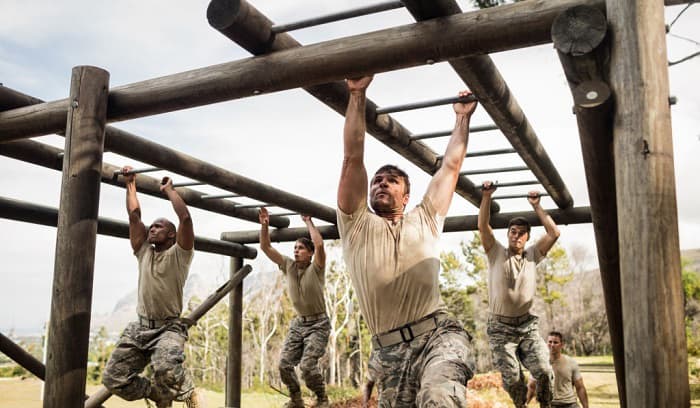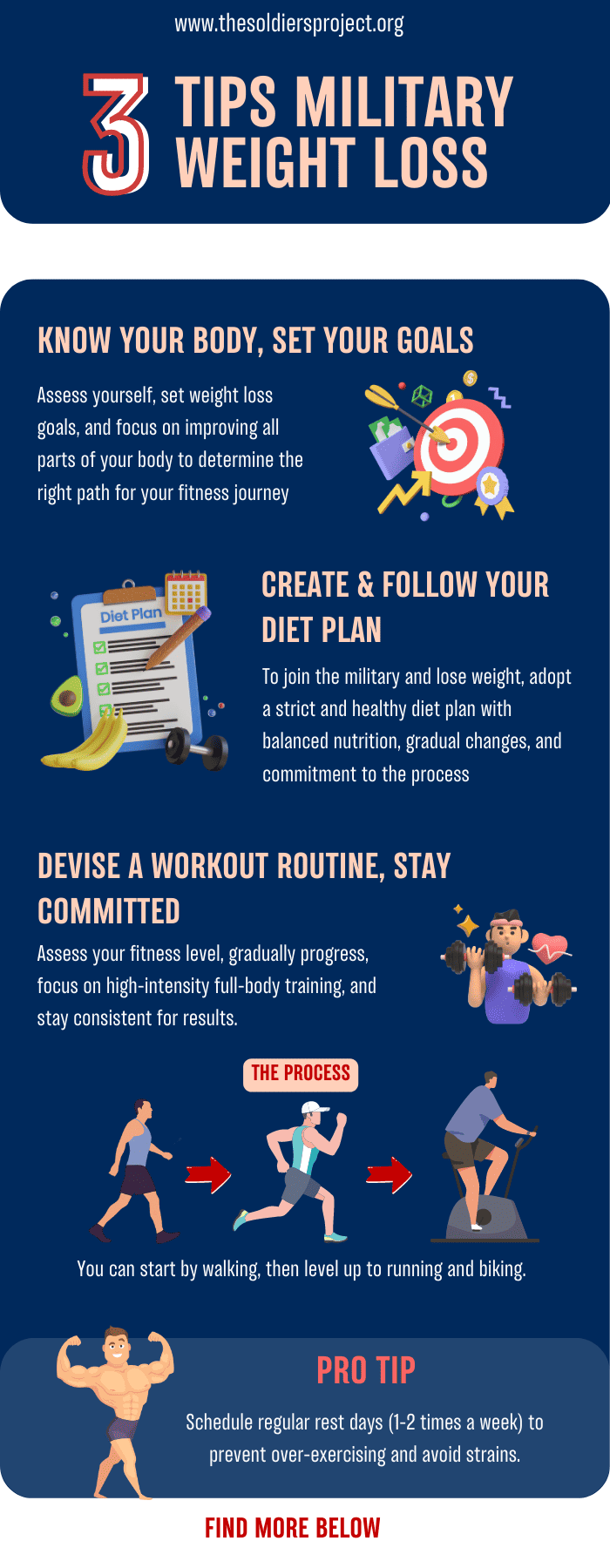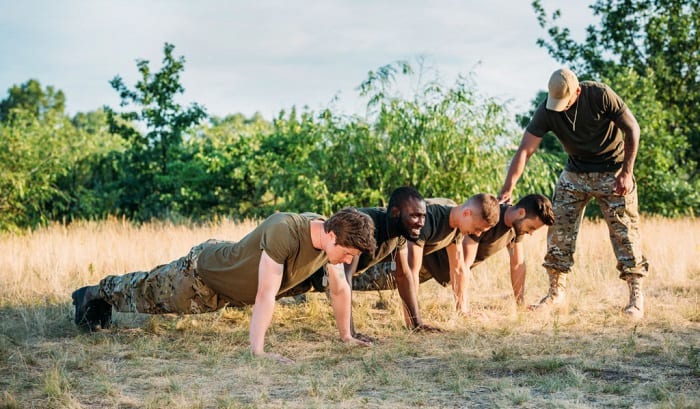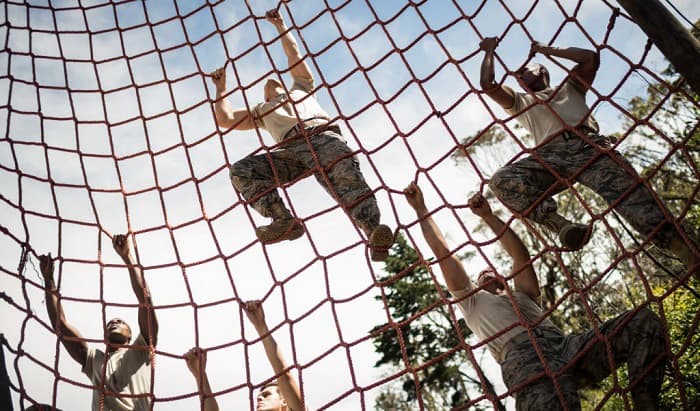One of the requirements you have to meet to become a military service member is the body composition test. If you weigh between 148 and 267 pounds as a male and 120 to 184 pounds as a female, then you are good to go.
Otherwise, you will have to invest time and effort in losing weight to join the military. It is definitely not an easy task. But it is not impossible either. You can start by reading how to lose weight for the military here. Briefly, you will need to:
- Understand your body and set your goals
- Create a diet plan and stick to it
- Come up with a workout routine and commit to it
Table of Contents
Lose Weight for Military Service
Step 1: Understand your body and set your goals
Before you jump into all the action with dumbbells and treadmills, you need to assess yourself. How many pounds do you need to lose? What areas are you falling short in? Ask yourself the tough questions, and from the answers, set your goals.
Generally, you will want to lose weight in all parts of your body and not just one. Nonetheless, it helps to know your body well to direct attention in the right places. It is very important that you have a clear idea of what you are working towards. Only when you know the destination, can you decide on the path to take!
Step 2: Create a diet plan and stick to it
Losing weight to join the military is a combination of eating right, sleeping right, and exercising right. First, for eating, you need a strict but healthy diet plan. Your meals should contain good nutrition from all groups of the food pyramid and level with the number of calories you burn.
Here are a few pointers for a safe and effective weight loss diet:
- Cut down on sugar, especially sugar from calorie-containing beverages, such as soda, sweet tea, etc. Always check product labels or descriptions for added sugar.
- Drink more water every day. According to the US National Academies of Sciences, Engineering and Medicine, 3.7 liters of fluids are needed for men and 2.7 liters for women.
- Switch fairy products to low or non-fat ones and replace “bad” or saturated fats with “good” or unsaturated fats. Examples of the latter are fats from nuts, avocado, and fish.
- Avoid eating takeaways and junk food or fast food. This also specifically refers to food items that are unhealthy and highly processed, like chips. Here is a website listing at least ten foods that you need to give up and forget about.
- Eat in smaller portions every three to four hours instead of feasting one large meal the entire day. Never ever starve yourself and resort to binge eating when you can no longer take it.
- Track your calorie intake so that you can burn the equivalent amount later in your workout routine.
- If you have specific medical conditions such as diabetes, then you should consult a registered dietitian or nutritionist to plan your diet.
It is not easy to completely change the way you eat overnight. So, be patient and gentle with yourself. It is perfectly acceptable to make one or two changes a day.
However, once you have a solid diet plan, you must stick to it. Do not waste your time and effort by “going on a diet” for a week, then announcing your defeat and returning to your old habits.
For more military-specific information on proper diet and nutrition, check out this website.
Step 3: Come up with a workout routine and commit to it
Start by determining the level you are at. This is necessary to keep your routine realistic and achievable. It also ensures that you push just enough to pass your limits and not compromise safety. If you are a fitness beginner, do not try to commit to a professional athlete’s routine.
You can start by walking, then level up to running and biking.
In addition to the body composition test, you will have to pass a fitness test, including running. More specifically, a 2-mile and 5-mile run. So, do NOT leave running out of your workout routine. You can run on a treadmill or outdoors.
You will also need to be able to do push-ups, sit-ups, and pull-ups. Thus, incorporate them into your exercises. If you are not able to do them yet, do not worry. Just start slowly and build your way up. There is no standard pace, the best pace is the one that works for you.
It is best to go for full-body training with a focus on high-intensity cardiovascular activities. Why? Because these work all of the major muscle groups in your body at once and thereby, improves strength, endurance, and muscle mass, all while trimming excess weight.
An important part of this step is coming up with a rightly calculated schedule. You will need to consider frequency and plan out your sessions carefully. Once you have your workout routine, stick to it. Do not adopt a new one just because you feel like it. Consistency is what will deliver desired results.
Note: Still, that is not to say that you cannot make adjustments to suit your body needs better. It is acceptable to be flexible but do not be purposefully inconsistent.
Make sure that your routine includes a warm-up and cool-down session. These may be between 10 minutes and 15 minutes. They are incredibly important to ensure that your workout is safe.
Top Tip: You should also schedule “rest days” once or twice a week. It is very critical to prevent yourself from over-exercising and ng strains.
You should also consider including swimming in your routine. Regardless of the military branch that you are looking forward to joining, being proficient at swimming is a must. It is even more necessary if you want to be a part of the Marines or Coast Guard.
If you are interested in finding out more about military swimming requirements, consider going through this detailed one-stop guide.
It does not matter if you work out at home or at the gym. If you have the necessary equipment at home, great! If not, investing in a gym membership card is not a bad idea.
Several other tips to help with this third step are:
- Some people feel more motivated when working out with somebody else. If you are like this, consider “sweating” it out with a buddy. You may have a fellow soon-to-be service member with the same goal, or maybe you can befriend one at the gym! Nowadays, there are plenty of online communities and mobile apps where you pair with “gym friends”. So, this is also an option.
- Getting a PT is another option. Not only will you have someone to push you, but a PT may also be more equipped with knowledge and experience to give you advice and help you design as well as commit to working out.
- Always carry a refillable water bottle with you. It is crucial to stay hydrated while you are exercising and losing water through sweat. You can also keep small, healthy snacks handy.
- Always remember: It is not going to be easy. But it will be rewarding. As the saying goes, no pain no gain. The first day may feel like a nightmare. However, do not give up. Have faith in yourself and power through!
- After all, losing weight for the army is not supposed to be easy. You will need to invest blood, sweat, and tears.
- Another reminder: You may not see results right away. Even so, it is important to not be discouraged. It may take months before you see a drop on the scale. Just be patient and work diligently. Rest assured that the outcomes will be worthwhile.
- Make sure that you track your progress. You can note them in a journal or your phone’s notes. If you have a fitness watch and corresponding app, be sure to sync in your data, like BMI, fat levels, etc. This lets you know how you are doing and how much you have left to go. Moreover, it is a surprisingly good source of motivation!
- A healthy weekly weight loss amount is 2 to 3 pounds. Therefore, do not expect or wish to trim off more than 10 pounds a week. Even though this appears satisfying, it is not a sustainable loss. Even if you do see this drop, it is most likely just a loss of water weight.
- Note: It is much better to commit to a long-term military weight loss program than to “lose your weight in 1 week!” hack blog posts on Pinterest.
- Sleeping is also an important part of your routine. Make sure you get enough sleep each day. This ensures that you always have enough energy to work out and further your goals. By the same token, never EVER exchange your sleep for “late-night” exercises.
With that, you have gone through the three necessary steps to lose weight for the military. Now, you can brush off the lingering thought “I want to join the military, but I’m overweight”.
Conclusion
Even though we have curated the information in just three steps, you can realize that losing weight for the military is not easy. It may even be an uphill battle. However, even so, it is not impossible as long as you have faith in yourself, stick to your plans, and work hard.
The key to mastering how to lose weight for the military is prioritizing yourself; eat right, sleep right, and exercise right. If you have any other helpful tips about this topic or questions, leave us comments. We are always looking forward to hearing from our readers. So, do not be hesitant!

I am Everett Bledsoe, taking on the responsibility of content producer for The Soldiers Project. My purpose in this project is to give honest reviews on the gear utilized and tested over time. Of course, you cannot go wrong when checking out our package of information and guide, too, as they come from reliable sources and years of experience.




